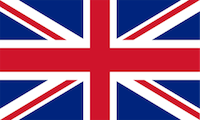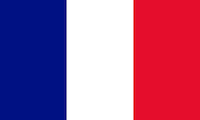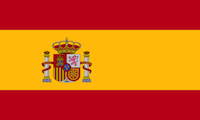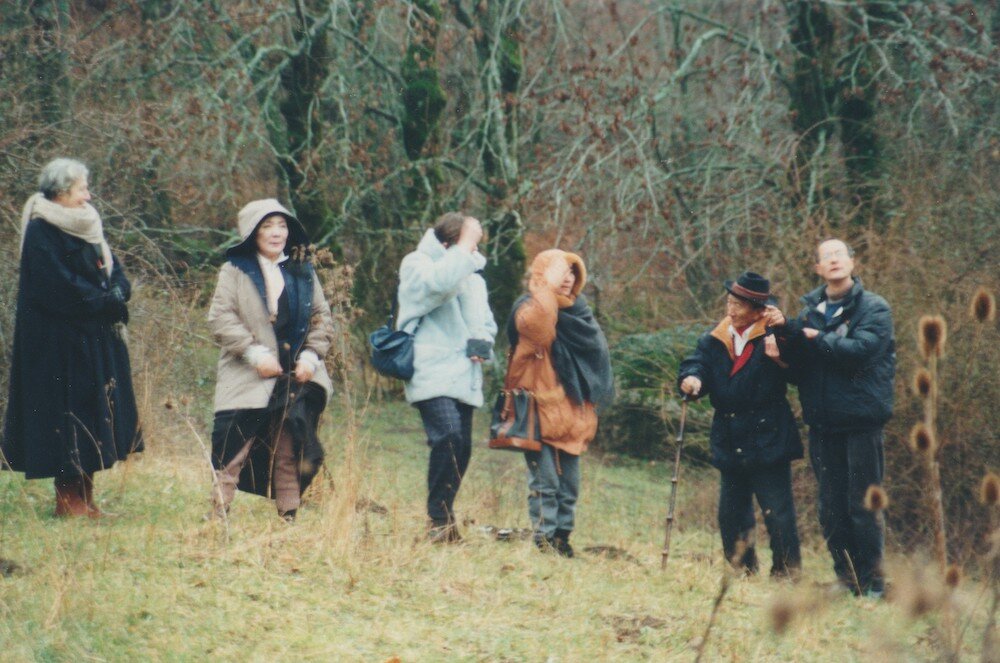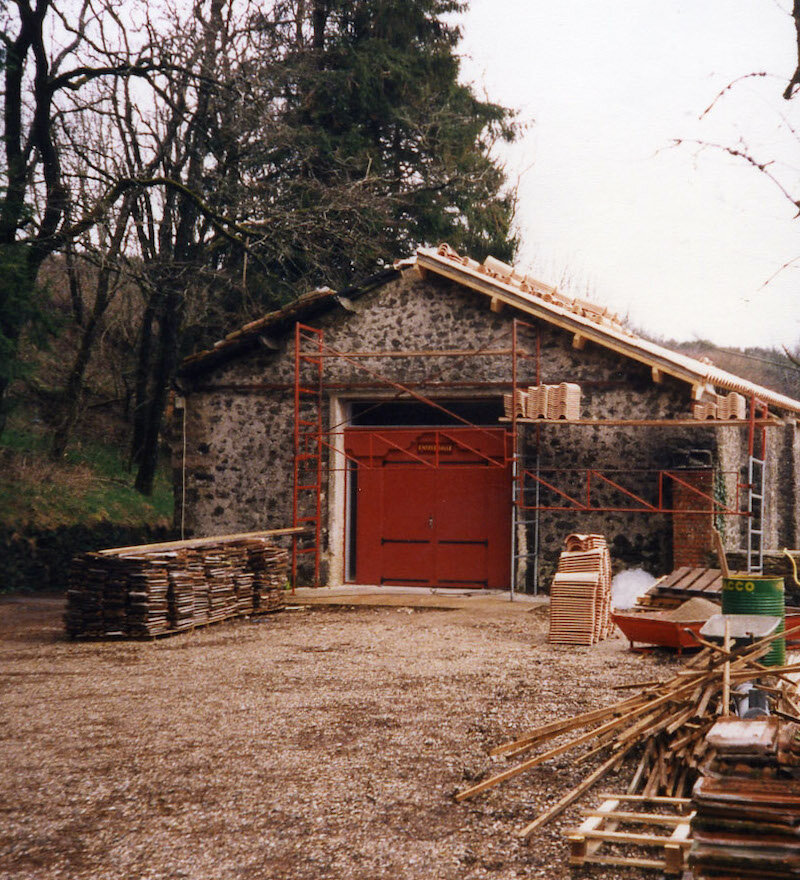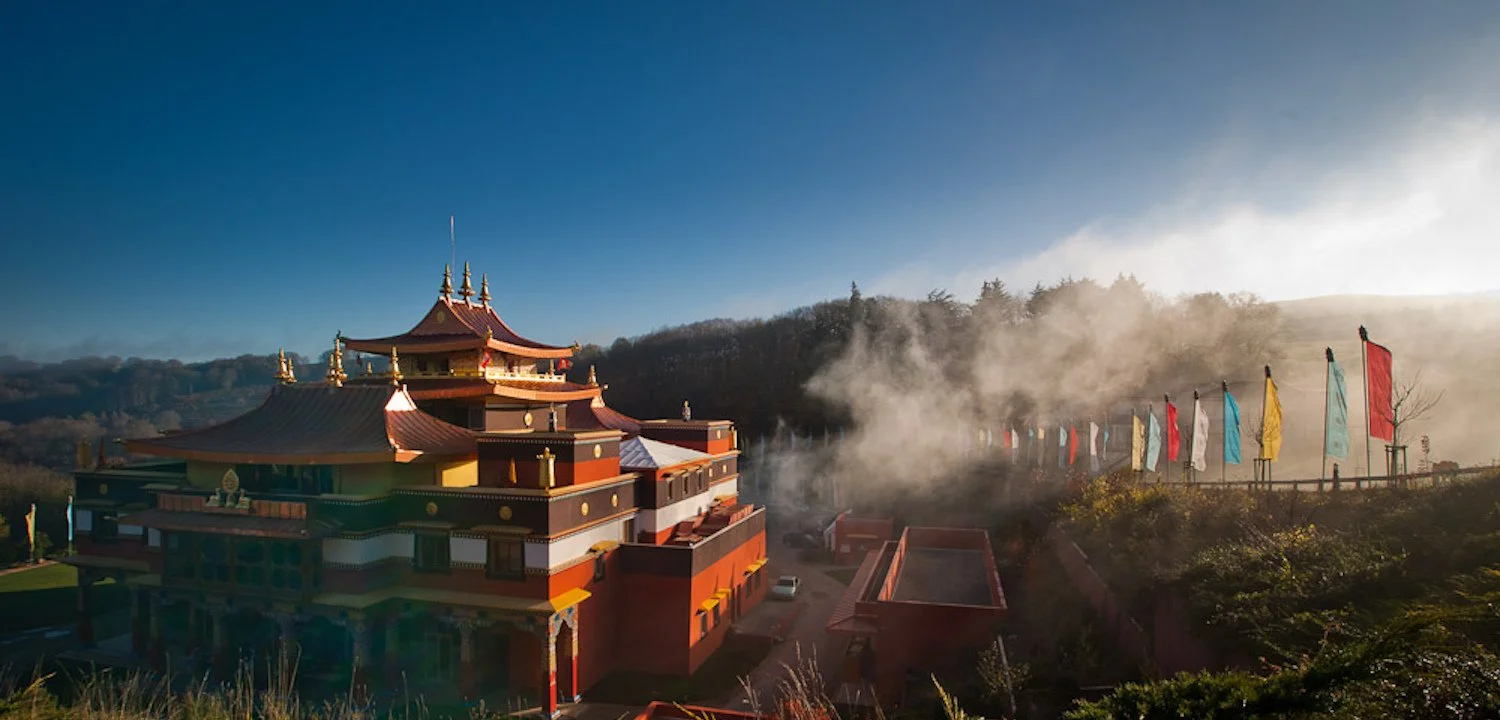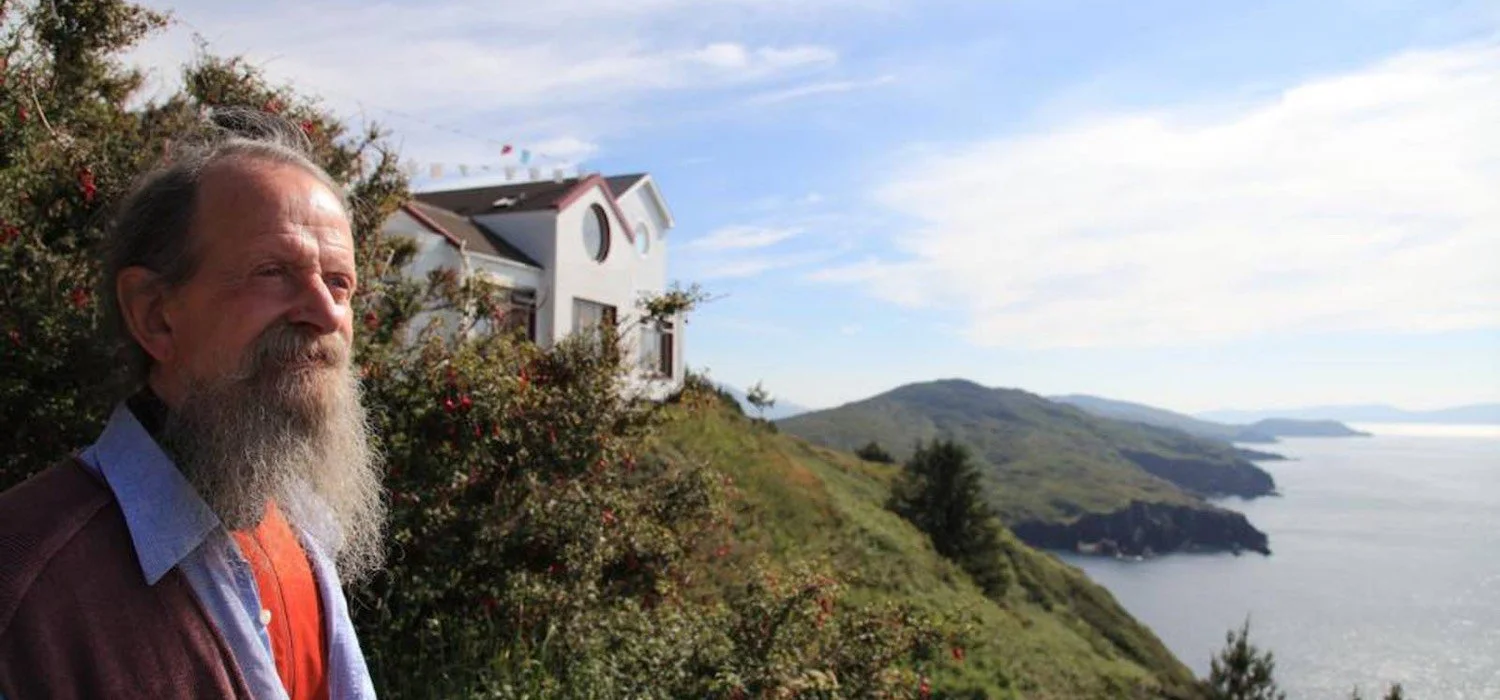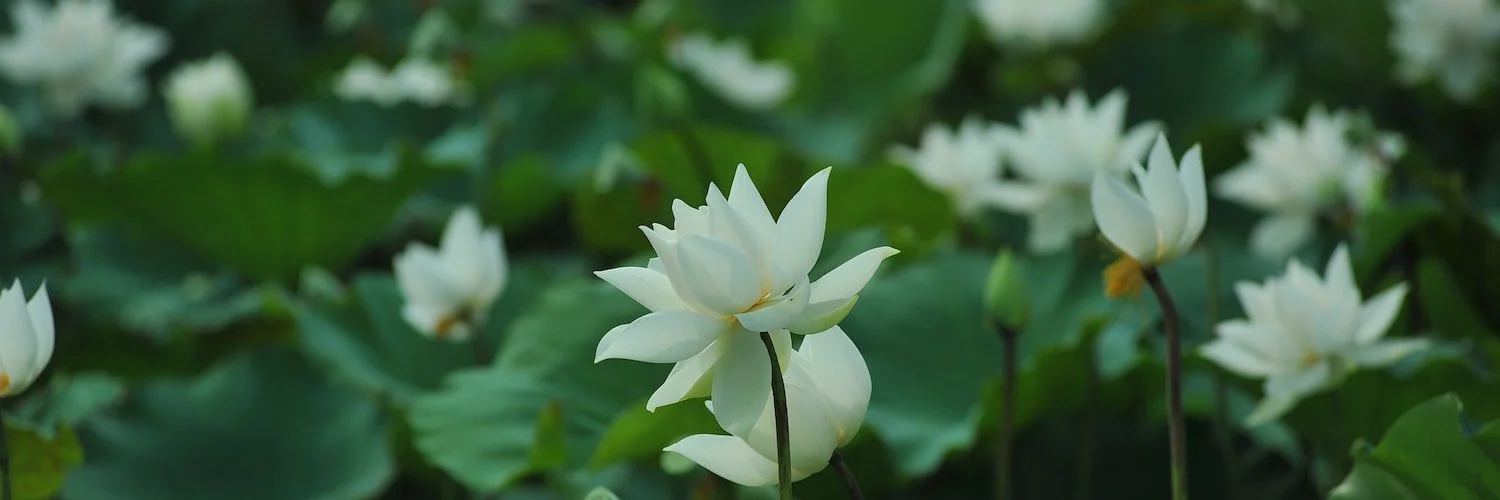The Early Days of Lerab Ling, A Place of Enlightened Activity
Naomi Gassler
This is the second in a series of blog posts about Lerab Ling as we celebrate Lerab Ling’s 30th Anniversary
While being slowly adapted to become a Tibetan Buddhist centre, Lerab Ling was used from day one as a place for teachings and practice. During its first two years of existence, it was visited by Kyabje Dodrupchen Rinpoche, hosted a three-month retreat with teachings by Sogyal Rinpoche, Dzogchen Rinpoche and many others, and provided the setting for the unique historic meeting of the two main incarnations of Tertön Sogyal.
Tsewang Paljor and Mayumla Tsering Wangmo
One of the first people to visit Lerab Ling on behalf of Sogyal Rinpoche, even before the legalities of the purchase of the land had been completed, was his father Tsewang Paljor. He was considered a highly skilled practitioner of the ancient Tibetan tradition of geomancy, which describes the spiritual interpretation of local geographic features such as bodies of water, hills, cliffs, forests and others and provides guidance on how to best orient and design spiritually significant structures such as temples in order for them to be in harmony with the surrounding land.
On a cold and snowy Winter day in January 1991, Tsewang Paljor visited the land of Lerab Ling together with Sogyal Rinpoche’s mother, Mayumla Tsering Wangmo. Rinpoche’s students had to organise an all-wheel vehicle to venture out to the land which was covered in snow and mud. Tsewang Paljor, already at an advanced age, seemed fragile as he slowly climbed into the pickup truck that brought them to Lerab Ling, but once he arrived there, he seemed to transform into an energetic young man, running and jumping around the land like a mountain goat, and giving advice on how the land should be developed to be most conducive as a place of study and practice.
Sogyal Rinpoche always invited great masters and lineage holders to Rigpa’s annual Summer retreats in Europe, to bestow important empowerments on the Rigpa sangha, and so that the sangha could forge a spiritual connection with these great teachers.
Dodrupchen Rinpoche blessing the Lerab Ling land
In 1991, Sogyal Rinpoche invited Dodrupchen Rinpoche to the summer retreat which was held in the Chateau of Cassan in the plains below Lerab Ling. Within a few days of Dodrupchen’s arrival, on 3 August, a mere three days after Rigpa became the legal owner of Lerab Ling, the entire retreat travelled up to the Lerab Ling hilltop to perform a traditional Tibetan practice called Sachok, the ceremony of the earth, which makes offerings to the local spirits and asks them for permission to use the land for spiritual activities where many small streams meet together to form the river Orb, one of the main waterways that empties into the Golf of Lyon. In fact, the land of Lerab Ling is called L’Engayresque in the local language of Occitan meaning ‘Land of Streams’. Dodrupchen Rinpoche named the stream that flows from the source below the Lerab Ling retreat centre ‘Ratna kanga’, the jewel river.
The First Three-Month Retreat in Lerab Ling
Following the powerful series of empowerments given by Dilgo Khyentse Rinpoche to the Rigpa sangha in Prapoutel in 1990, Sogyal Rinpoche envisaged a three-month retreat where he could introduce his students more systematically to the teachings of the Dzogchen tradition.
For a while, it was unclear whether this retreat would be held in Dzogchen Beara in Ireland or in Lerab Ling. In the end, it seemed that Lerab Ling would be a better location for the retreat, and so preparations began to transform the derelict farm into a retreat place.
First, an extensive cleanup was needed to remove old rusty farming equipment, carcasses of old cars, and many other debris. Then, the old two-storey barn building was cleaned and prepared. The upstairs area became the shrine room which could hold over 200 people, and the downstairs area which had previously been the home of cows now was turned into a makeshift dining hall. Hastily, some large tables made of raw plywood and some benches were constructed and placed on the compressed earth that not long ago was trampled on by cows—now it was called the dining hall. A small wooden chalet was constructed to accommodate Sogyal Rinpoche while the main building housed the retreat kitchen. The retreatants were accommodated in tents.
Finally, on 1 June 1992 Rigpa’s the first three-month retreat began, attended by three hundred students and led by Sogyal Rinpoche and Dzogchen Rinpoche.
The former barn of the farm is being transformed into a Tibetan Buddhist shrine room, Lerab Ling, 1992
Sogyal Rinpoche teaching on the ‘Teaching Stone’, Lerab Ling, 1992
Most teachings very given in the teaching tent, but Rinpoche also tried out other teaching locations including the hilltop, a meadow overlooking the valley, and an ancient-looking boulder in the centre of a meadow down in the valley.
One memorable feature of the retreat was the unusual weather. Normally the summer months in this area are quite hot and dry with only occasional rain and sometimes an entire summer might pass without any rain at all. In 1992 however, it seemed that the sky’s only purpose was to deliver as much rain as possible. The local people in the area who were devout Catholics joked that they were undergoing a continual baptism. The retreatants in their tents resorted to rubber boots and hot-water-bottles to keep themselves dry and warm.
Garje Khamtrul Rinpoche, Lerab Ling, 1992
Garje Khamtrul Rinpoche, a Nyingma lama in the lineage of Tertön Sogyal, visited the retreat, taught on the life of Tertön Sogyal, and shared his insights into the spiritual significance of features of the land and the surrounding hills and valleys. He vividly described seeing the shape of the Four Protectors of the land which are in essence the Four Immeasurables. Based on the shape of the hills around Lerab Ling he predicted that Lerab Ling will be home to important female practitioners.
During the retreat, Rinpoche together with Patrick Gaffney and Andrew Harvey put the final touches on The Tibetan Book of Living and Dying. Rinpoche also encouraged the sangha to prepare for the anticipated increase of public interest in Rigpa and in Rinpoche’s teachings.
The Summer of 1993 and the Visit of Khenpo Jikme Phuntsok Rinpoche
Starting in June 1993, Rinpoche gathered his older students for a second Three-Month retreat in Lerab Ling. A new teaching tent that could hold up to 700 people had just been erected but it would take 12 more years until the construction of the now famous Lerab Ling temple was embarked upon. More than five hundred students from Europe, the United States and Australia attended. Unlike the previous year however, Rinpoche now was engaged in the promotion of his book, and so he spent the second half of June away from Lerab Ling.
The first teacher to visit the retreat was the renowned Zen master and Buddhist monk Thich Nhat Hanh, a pioneer of bringing dharma teachings to West. He conducted a three-day mindfulness workshop and taught a group of children who had come to Lerab Ling with their parents for the retreat.
The highlight of the 1993 Summer was the visit of Khenpo Jikme Phuntsok Rinpoche, an incarnation of Tertön Sogyal and one of the most important masters living in Tibet in the second half of the 20th century. On 24 August 1993, Khenpo Jigphun arrived together with Tulku Kalzang, Khenpo Namdrol, Khenpo Sodargye, and his niece Jetsün Mingyur Drolma. It was the first time that the two main reincarnations of Tertön Sogyal, Lerab Lingpa, met. In his speech following the welcome in Lerab Ling by Sogyal Rinpoche, Dzogchen Rinpoche, and Ringu Tulku Rinpoche, Khenpo Jigphun humbly declared that Sogyal Rinpoche was the one real incarnation of Tertön Sogyal, while he himself only accepted the name Lerab Lingpa for the sake of the continuation of Lerab Lingpa’s work and his teachings. He also reminded the assembled audience about Tertön Sogyal’s prediction about the impact of his teachings.
“In the predictions of Tertön Sogyal's Drolö Deshek Düpa it says that during his own lifetime, his teachings would not spread very far, only to a small extent in central Tibet around the 13th Dalai Lama and himself. During his second incarnation, however, his teachings would flourish and become known all over the world. Now, when I see the work of Sogyal Rinpoche, I am convinced that he is the reincarnation of Tertön Sogyal, and I am filled with faith and confidence in him.”
Khenpo Jigphun also repeated Tertön Sogyal’s prediction that the impact, power, and blessing of his teachings would multiply hundredfold during the lifetime of his incarnation, and would then remain without any decline for 500 years.
Khenpo Jigphun, Sogyal Rinpoche, and Khenpo Sodargye outside Rinpoche’s private shrine room in Lerab Ling, 30 August 1993
Khenpo Jigphun bestowed the empowerment of Tertön Sogyal’s terma of Tendrel Nyesel which is one of the main sadhanas practiced by the Rigpa sangha as well as empowerments of other termas of Tertön Sogyal, including Vajrakilaya and Manjushri, and gave essential Dzogchen teachings. Privately, he revealed that when he saw Sogyal Rinpoche and especially his students, he came to appreciate them even more, and that he saw clear signs that the teachings and practice of Dharma are being authentically established in the West.
Starting a new tradition, Sogyal Rinpoche took Khenpo Jigphun on a tour of Lerab Ling’s most beautiful spot, starting with the hilltop where, together with the sangha, they engaged in a practice of Riwo Sangchö. Then they took a troop down the valley to a series of cascades where Rinpoche had constructed a small wooden hut, which he affectionately called the Teahouse.
Khenpo Jigphun with Dzogchen Rinpoche and Sogyal Rinpoche on Lerab Ling’s hilltop, France, 29 August 1993
Khenpo Jigphun enjoying tea and some light refreshments on the teahouse of Lerab Ling, 29 August 1993
☟SCROLL to the bottom of the page to share your comments.

